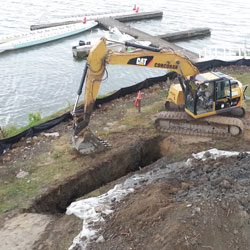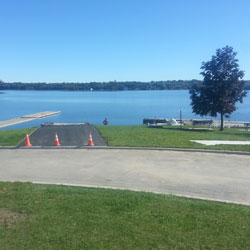Emma Martin Park
Emma Martin Park
Project Profile: Innovative Groundwater Remediation
Emma Martin Park is located on the shores of the Cataraqui River in Kingston's scenic Inner Harbour. The Park sits on lands previously used by tannery and smelting operations, but is now a public park beside a rowing/canoe club and the beautifully-restored Woolen Mill – now a commercial building hosting many successful businesses.
The Issue
Contaminated soil and groundwater
The site's industrial past left it with contaminants in its soil such as arsenic and other metals that required a management approach that prevents contamination of the river through the seepage of contaminated groundwater moving through the soil.
The Solution
ZVI-PRB Wall bench tests resulted in a 99.98% reduction in concentrations in a month
The City incorporated an innovative approach to groundwater remediation (filtering) that reduced the arsenic concentrations in the groundwater by 99.98% to 0.0036 ppm! This entirely effective solution also proved to be 40 per cent more cost-efficient than the more traditional "Dig & Dump" method, which moves the problem elsewhere and requires more time and energy to remediate the soil and groundwater.
The City installed an underground Zero Valent Iron Permeable Reactive Barrier (or ZVI-PRB) Wall, which basically filters and cleans the groundwater. More specifically, it absorbs dissolved arsenic to iron hydroxides as groundwater filters through it and undergoes electrochemical reduction.
The ZVI-PRB Wall is constructed of several layers of material consisting of (top layer, first):
- 0.75m of limestone (and some areas covered with grass/asphalt) – above ground
- 0.50m of sand fill
- a Geotextile Layer cap
- 2.25m of a mixture of 40% ZVI (which reduces Arsenic) and sand
- 0.50m of a Clay Confining Layer

Benefits
A lower cost, less disruptive sustainable solution
This method required far less soil to be removed – about 230 metric tonnes in total with the ZVI-PRB Wall versus 1,000 metric tonnes with the "Dig & Dump" method.
This saved the fuel, time and energy associated with hauling 50 full dump truck loads of contaminated soil three hours away and hauling in 50 full dump trucks of clean replacement soil. That's a savings of about 17,000 litres – or more than $23,000-worth – of fuel plus associated labour and equipment costs. This method also reduced disposal and backfill costs and minimized the disruption to park and area users.
As a bonus, the remediation work offered a good opportunity to enhance the area with additional parking, pathway improvements and landscape design.

During Construction

Completed Project
